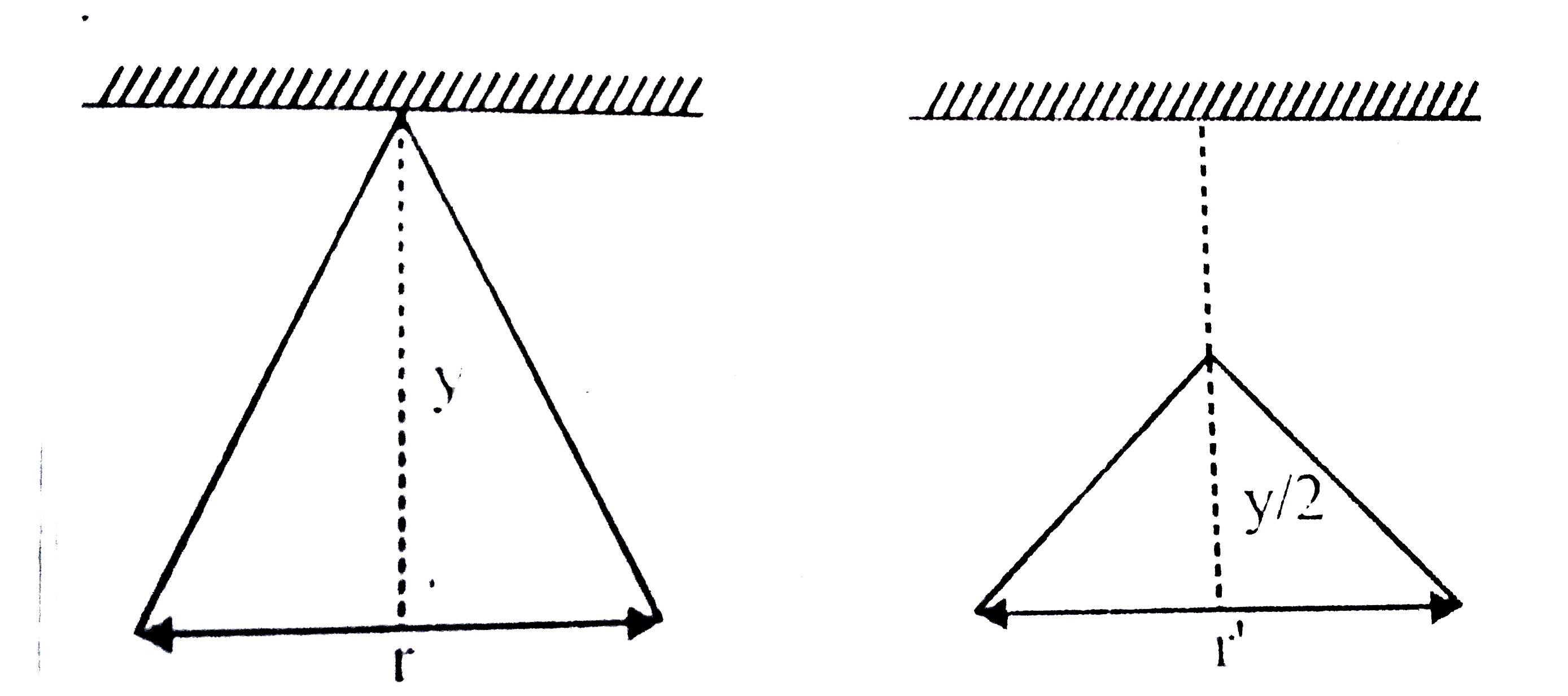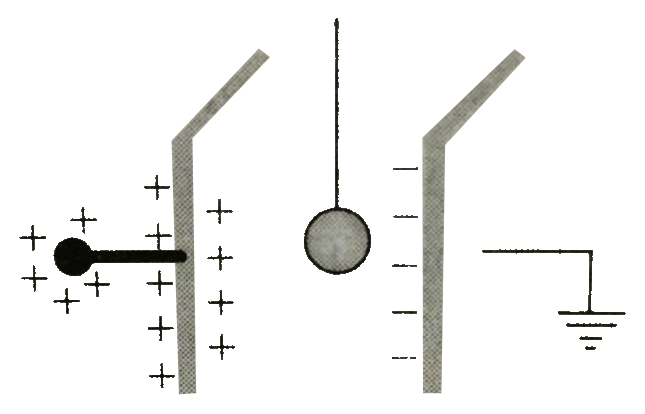Three small equally charged identical conducting balls are suspended from identical insulating threads secured at one point. Length (L) of the threads is large compared to the equilibrium separation (a) between any two balls. (a) One of the balls is suddenly discharged. Find the separation between the charged balls when equilibrium is restored. Assume that the threads do not interfere and balls do not collide. (b) If two of the balls are suddenly discharged, how will the balls behave after this? Find the separation between the balls when equilibrium is restored. The threads do not interfere
The correct Answer is:(a). (23)13a
(b). (19)13a
To solve the problem step by step, we will analyze the situation of the three charged balls suspended from insulating threads.
Part (a): One Ball is Discharged
1. Initial Setup:
- We have three identical conducting balls, each with charge Q, suspended from a common point by insulating threads of length L.
- When in equilibrium, the balls repel each other due to their identical charges, and the distance between any two balls is a.
2. Forces Acting on the Balls:
- Each ball experiences two forces: the gravitational force mg acting downwards and the electrostatic force Fe acting horizontally due to the repulsion from the other charged balls.
- The electrostatic force between any two balls is given by:
Fe=kQ2a2
- Here, k is Coulomb's constant.
3. Equilibrium Condition:
- In equilibrium, the vertical component of the tension in the thread balances the weight of the ball, and the horizontal component balances the electrostatic force.
- If we denote the angle between the thread and the vertical as θ, we can write:
Tcosθ=mg(1)
Tsinθ=Fe(2)
4. Using Geometry:
- The horizontal distance between the balls can be expressed as a=2Lsinθ.
- From the geometry of the setup, we can also express tanθ as:
tanθ=Femg
5. Substituting Forces:
- From equations (1) and (2):
tanθ=kQ2a2mg
- Substituting a=2Lsinθ into the equation gives us a relationship between a, L, Q, and m.
6. Discharging One Ball:
- When one ball is discharged, it loses its charge, and the remaining two balls will now have a charge Q each.
- The new electrostatic force between the two remaining charged balls is:
F′e=kQ2x2
- The distance between the two charged balls is now x.
7. New Equilibrium:
- The new equilibrium condition can be set up as:
T′sinθ′=2F′e=2kQ2x2
- The vertical component remains the same:
T′cosθ′=mg
- Using the geometry again, we can relate x to L and θ′.
8. Final Calculation:
- By equating the forces and using the relationships derived, we can solve for x:
x3=2kQ2Lmg
- Thus, the new separation x can be calculated as:
x=(2kQ2Lmg)1/3
Part (b): Two Balls are Discharged
1. Discharging Two Balls:
- When two balls are discharged, they will share their charge equally.
- Each ball will then have a charge of Q3.
2. New Electrostatic Force:
- The new electrostatic force between the two remaining charged balls is:
F′′e=k(Q3)2y2=kQ29y2
- The distance between the two charged balls is now y.
3. New Equilibrium Condition:
- The equilibrium condition will be similar to before:
T′′sinθ′′=2F′′e=2kQ29y2
- The vertical component remains:
T′′cosθ′′=mg
4. Final Calculation:
- By setting up the equations and using the relationships derived, we can solve for y:
y3=3kQ2Lmg
- Thus, the new separation y can be calculated as:
y=(3kQ2Lmg)1/3
Summary of Results:
- (a) The separation between the charged balls when one ball is discharged is:
x=(2kQ2Lmg)1/3
- (b) The separation between the balls when two balls are discharged is:
y=(3kQ2Lmg)1/3
- We have three identical conducting balls, each with charge Q, suspended from a common point by insulating threads of length L.
- When in equilibrium, the balls repel each other due to their identical charges, and the distance between any two balls is a.
- Each ball experiences two forces: the gravitational force mg acting downwards and the electrostatic force Fe acting horizontally due to the repulsion from the other charged balls.
- The electrostatic force between any two balls is given by:
Fe=kQ2a2
- Here, k is Coulomb's constant.
- In equilibrium, the vertical component of the tension in the thread balances the weight of the ball, and the horizontal component balances the electrostatic force.
- If we denote the angle between the thread and the vertical as θ, we can write:
Tcosθ=mg(1)
Tsinθ=Fe(2)
- The horizontal distance between the balls can be expressed as a=2Lsinθ.
- From the geometry of the setup, we can also express tanθ as:
tanθ=Femg
- From equations (1) and (2):
tanθ=kQ2a2mg
- Substituting a=2Lsinθ into the equation gives us a relationship between a, L, Q, and m.
- When one ball is discharged, it loses its charge, and the remaining two balls will now have a charge Q each.
- The new electrostatic force between the two remaining charged balls is:
F′e=kQ2x2
- The distance between the two charged balls is now x.
- The new equilibrium condition can be set up as:
T′sinθ′=2F′e=2kQ2x2
- The vertical component remains the same:
T′cosθ′=mg
- Using the geometry again, we can relate x to L and θ′.
- By equating the forces and using the relationships derived, we can solve for x:
x3=2kQ2Lmg
- Thus, the new separation x can be calculated as:
x=(2kQ2Lmg)1/3
- When two balls are discharged, they will share their charge equally.
- Each ball will then have a charge of Q3.
- The new electrostatic force between the two remaining charged balls is:
F′′e=k(Q3)2y2=kQ29y2
- The distance between the two charged balls is now y.
- The equilibrium condition will be similar to before:
T′′sinθ′′=2F′′e=2kQ29y2
- The vertical component remains:
T′′cosθ′′=mg
- By setting up the equations and using the relationships derived, we can solve for y:
y3=3kQ2Lmg
- Thus, the new separation y can be calculated as:
y=(3kQ2Lmg)1/3
- (a) The separation between the charged balls when one ball is discharged is:
x=(2kQ2Lmg)1/3
- (b) The separation between the balls when two balls are discharged is:
y=(3kQ2Lmg)1/3
Topper's Solved these Questions
Similar Questions
Two identical small equally charged conducting balls are suspended from long threads secured at one point. The charges and masses of the balls are such that they are in equilibirum whaen th distance between them is a(the length of thread L>>a). Then one of the balls is discharged. what will be the distance b(b<<L) between the balls when equilibrium is restored?
View SolutionTwo small equally charged identical conducting balls are suspended from long threads secured at one point. The charges and masses of the balls are such that they are in equilibrium when the distance between them is 10 cm (the length of the threads >>10 cm.) One of the balls is then discharged. How will the balls behave after this ? What will be the distance between the balls when equilibrium is restored ?
View Solution
Knowledge Check
- Question 1 - Select One
Two path balls carrying eqaul chareges are suspended froom a common point by strings of equal length, the strings are rightly clamped at half the height. The equilibrium separation between the balls, now becomes :
 A(2r3)B(1√2)2C(r3√2)D(2r√3)
A(2r3)B(1√2)2C(r3√2)D(2r√3) - Question 2 - Select One
Two identical tennis balls each having mass 'm' and charge 'q' are suspended from a fixed point by threads of length 'l'. What is the equilibrium separation when each thread makes a small angle 'θ' with the vertical ?
Ax=(q2l2πε0mg)1/2Bx=(q2l2πε0mg)1/3Cx=(q2l22πε0m2g)1/3Dx=(q2l22πε0m2g2)1/3 - Question 3 - Select One
Two equally charged small metal balls placed at a fixed distance experience a force F. A similar unchanged metal ball after touching one of them is placed at the middle point between the two balls. The force experienced by this ball is
AF2BFC2FD4F
Two small equally charged identical conducting balls are suspended from long threads from the same point. The charges and asses of the balls are such that they are in equilibrium. The distance between them is a=(108)1/3 cm (the length of the threads L>>a). One of the ball is discharged. after sometime both balls comes to rest in equilibrium. what will be the distance b (in cm) between the balls when equilibrium is restored ?
View SolutionTwo pitch balls carrying equal charges are suspended from a common point by strings of equal length, the equilibrium separation between them is r. Now the strings are rigidly clamped at half the height. The equilibrium separation between the balls now become
 View Solution
View SolutionA table tennis ball covered with a conducting paint is suspended by a silk thread so that it hangs between tow metal plates. One plate is earthed, when the other plate is connected to a high voltage generator, what will happen to the ball.
 View Solution
View SolutionTwo small identical balls carrying the charges of the same sign are suspended from the same point by insulating threads of equal length. When the surrounding space was filled with kerosene the divergence angle between the threads remained constant, What is the density of the material of which the balls are made ?
View SolutionTwo small spheres, each having a mass of 20 g, are suspended form a common point by two insulating strings of length 40 cm each. The spheres are identically charged and the speration between the balls at equilibrium is found to be 4 cm . Find the charge on each sphere.
View Solution
